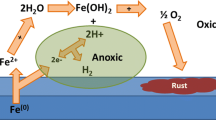Abstract
This study was conducted to analyze the methanogen population in a corrosive marine biofilm based on 16S rDNA analysis, using a PCR-cloning-sequencing approach. There were 80 methanogen clones developed from the PCR-amplified DNA extracted from the biofilm on the mild steel surface. All clones were categorized into one of five operational taxonomy units (OTUs). Two OTUs (comprising 57 clones) were affiliated with the acetotrophic Methanosaeta genus; the remaining three OTUs (23 clones) were affiliated with the hydrogenotrophic genera of Methanogenium, Methanoplanus and Methanocalculus. The hydrogenotrophic methanogens could directly cause metal corrosion through cathodic depolarization, whereas the acetotrophic methanogens grew syntrophically with corrosion-causing sulfate-reducing bacteria, as observed by fluorescent in situ hybridization, and thus contribute indirectly to metal corrosion.




Similar content being viewed by others
References
Altschul SF, Gish W, Miller W, Myers E, Lipman DJ (1990) Basic local alignment search tool. J Mol Biol 215:403–410
Amann RI, Krumholz L, Stahl DA (1990) Fluorescent-oligonucleotide probing of whole cells for determinative, phylogenetic and environmental studies in microbiology. J Bacteriol 172:762–770
Amann RI, Ludwig W, Schleifer K (1995) Phylogenetic identification and in situ detection of individual microbial cells without cultivation. Microbiol Rev 59:143–169
Boopathy R, Daniels L (1991) Effect of pH on anaerobic mild steel corrosion by methanogenic bacteria. Appl Environ Microbiol 57:2104–2108
Daniel S, Stephan S (2001) Structure and diversity of Gram-negative sulfate-reducing bacteria on rice roots. FEMS Microbiol Ecol 36:175–183
Daniels L, Belay N, Basavapatna SR, Weimer PJ (1987) Bacterial methanogenesis and growth from CO2 with element iron as the sole source of electrons. Science 237:509–511
Felsenstein J (1985) Confidence limits of phylogenies: an approach using the bootstrap. Evolution 39:783–791
Giovannoni SJ, Britschgi TB, Moyer CL, Field KG (1990) Genetic diversity in Sargasso Sea bacterioplankton. Nature 345:60–63
Hall TA (1999) BioEdit: a user-friendly biological sequence alignment editor and analysis program for Windows 95/98/NT. Nucleic Acids Symp Ser 41:95–98
Holt JG, Krieg NR, Sneath PH, Staley JT, Williams ST (1994) Bergey's manual of determinative bacteriology, 9th edn. Williams and Wilkins, Baltimore
Kumar S, Tomura K, Nei M (1993) MEGA: molecular evolution genetics analysis, version 1.0, The Pennsylvania State University, Philadelphia, Pa.
Lanoil BD, Sassen R, La Duc MT, Sweet ST, Nealson KH (2001) Bacteria and Archaea physically associated with Gulf of Mexico gas hydrates. Appl Environ Microbiol 67:5143–5153
Li YY, Lam S, Fang HHP (1996) Interactions between methanogenic, sulfate-reducing and syntrophic acetogenic bacteria in the anaerobic degradation of benzoate. Water Res 30:1555–1562
Liu WT, Chan OC, Fang HHP (2002) Characterization of microbial community in granular sludge treating brewery wastewater. Water Res 36:1767–1775
Maidak BL, Olsen GJ, Larsen N, Overbeek R, McCaughey MJ, Woese CR (1997) The RDP (Ribosomal Database Project). Nucleic Acid Res 25:109–110
McHugh S, Carton M, Mahony T, O'Flaherty V (2003) Methanogenic population structure in a variety of anaerobic bioreactors. FEMS Microbiol Lett 219:297–304
Orphan VJ, Taylor LT, Hafenbradl D, Delong EF (2000) Culture-dependent and culture-independent characterization of microbial assemblages associated with high-temperature petroleum reservoirs. Appl Environ Microbiol 66:700–711
Raskin L, Stromley JM, Rittmann BR, Stahl DA (1994) Group-specific 16S rRNA hybridization probes to describe natural communities of methanogens. Appl Environ Microbiol 60:1232–1240
Raskin L, Rittmann BE, Stahl DA (1996) Competition and coexistence of sulfate-reducing and methanogenic populations in anaerobic biofilms. Appl Environ Microbiol 62:3847–3857
Sambrook J, Fritsch EJ, Maniatis T (1989) Molecular cloning: a laboratory manual, 2nd edn. Cold Spring Harbor Laboratory Press, Cold Spring Harbor, N.Y.
Sandaa RA, Torsvik V, Enger Ø (2001) Influence of long-term heavy-metal contamination on microbial communities in soil. Soil Biol Biochem 33:287–295
Stahl DA, Flesher B, Mansfield HR, Montgomery L (1988) Use of phylogenetically based hybridization probes for studies of ruminal microbial ecology. Appl Environ Microbiol 54:1079–1084
Teske A, Hinrichs KU, Edgcomb V, de Vera Gomez A, Kysela D, Sylva SP, Sogin ML, Jannasch HW (2002) Microbial diversity of hydrothermal sediments in the Guaymas Basin: evidence for anaerobic methanotrophic communities. Appl Environ Microbiol 68:1994–2007
Videla HA (1996) Manual of biocorrosion. Lewis, Boca Raton, Fla., p 252
Ward DM, Winfrey MR (1985) Interactions between methanogenic and sulfate-reducing bacteria in sediments. Adv Aquat Microbiol 3:141–179
Wilson M, Patel H, Kpendema H, Noar JH, Hunt NP, Mordan NJ (1997) Corrosion of intra-oral magnets by multi-species biofilms in the presence and absence of sucrose. Biomaterials 18:53–57
Wolzogen Kuhr CAH von, van der Vlugt IS (1934) The graphitization of cat iron as an electrochemical process in anaerobic solid. Water 18:147–165
Xu LC, Fang HHP, Chen KY (1999) Atomic force microscopy study of microbiologically influenced corrosion of mild steel. J Electrochem Soc 146:4455–4460
Zengler K, Richnow HH, Rossello-Mora R, Michaelis W, Widdel F (1999) Methane formation from long-chain alkanes by anaerobic microorganisms. Nature 401:266–269
Zhang T, Fang HHP (2000) Digitization of DGGE (denaturing gradient gel electrophoresis) profile and cluster analysis of microbial communities. Biotechnol Lett 22:399–405
Zhang T, Fang HHP (2001) Phylogenetic diversity of a SRB-rich marine biofilm. Appl Microbiol Biotechnol 57:437–440
Acknowledgement
The authors wish to thank the Hong Kong Research Grants Council for the financial support of this project (HKU 7004/00E).
Author information
Authors and Affiliations
Corresponding author
Rights and permissions
About this article
Cite this article
Zhang, T., Fang, H.H.P. & Ko, B.C.B. Methanogen population in a marine biofilm corrosive to mild steel. Appl Microbiol Biotechnol 63, 101–106 (2003). https://doi.org/10.1007/s00253-003-1396-2
Received:
Revised:
Accepted:
Published:
Issue Date:
DOI: https://doi.org/10.1007/s00253-003-1396-2




